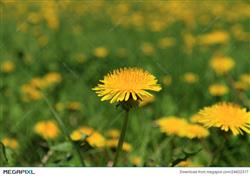Lawn Covered in Dandelions?

If you are like many of us, you may have woken up one morning this spring to find that your lawn was covered in dandelions, seemingly overnight. Are you wondering what to do? Is now the right time to treat the lawn for them? Should you just leave them and enjoy the flowers and pollinator habitat? Dandelions are a perennial weed that come up every year around this time. They are quite common and sometime difficult to control. After flowering in the spring, they quickly go to seed, spreading easily over the landscape. These seeds will develop over the summer, and create new plants for the fall, which will overwinter and start the cycle over again.
So how do you take care of them? One option would be to leave them and enjoy the bright yellow flowers and leave a habitat for bees. However, if you are trying to maintain a pristine lawn, you may want to treat for them before they get out of hand. A few things to consider before coming up with a treatment plan: how many applications do I want to make, and how much money am I willing to spend? Keep in mind that 100% eradication will be nearly impossible, as dandelion seeds will always float in from other places.
If you are intent on only making one application, fall may be the best timing at this point. This is when dandelions are sending energy down into their roots preparing for winter, making a herbicide more effective. As anyone who has ever tried to pull a dandelion out of the ground knows, they have a very deep and strong taproot, making it crucial to do more than just burn off the above ground foliage. If the dandelions are really bothering you and you don’t mind throwing another treatment at the problem, a springtime application may be acceptable. This treatment can help kill the flowers so that no more seeds are produced. This treatment may help with the flower, but may not get down to the root, which is why following up with a fall treatment is recommended.
For further information, including product recommendations, refer to the publication “Control of Broadleaf Weeds in Home Lawns,” AY-6-W. Many of the recommended products will have an ingredient called 2, 4-D, which is somewhat susceptible to drifting so please apply carefully especially around younger, more sensitive plants. A few things that may help include: spot spraying in areas with fewer weeds, applying on a clear and calm day, and not applying when rain is in the forecast in the next 24 hours.
Cultural control will also go a long way in weed control. These include: mowing at no shorter than 3 – 3.5,” irrigating during drought, and applying a fall fertilizer application of 2 – 4 pounds of nitrogen per 1,000 ft². This application works best if it is split between two applications: one in September and one in November.

